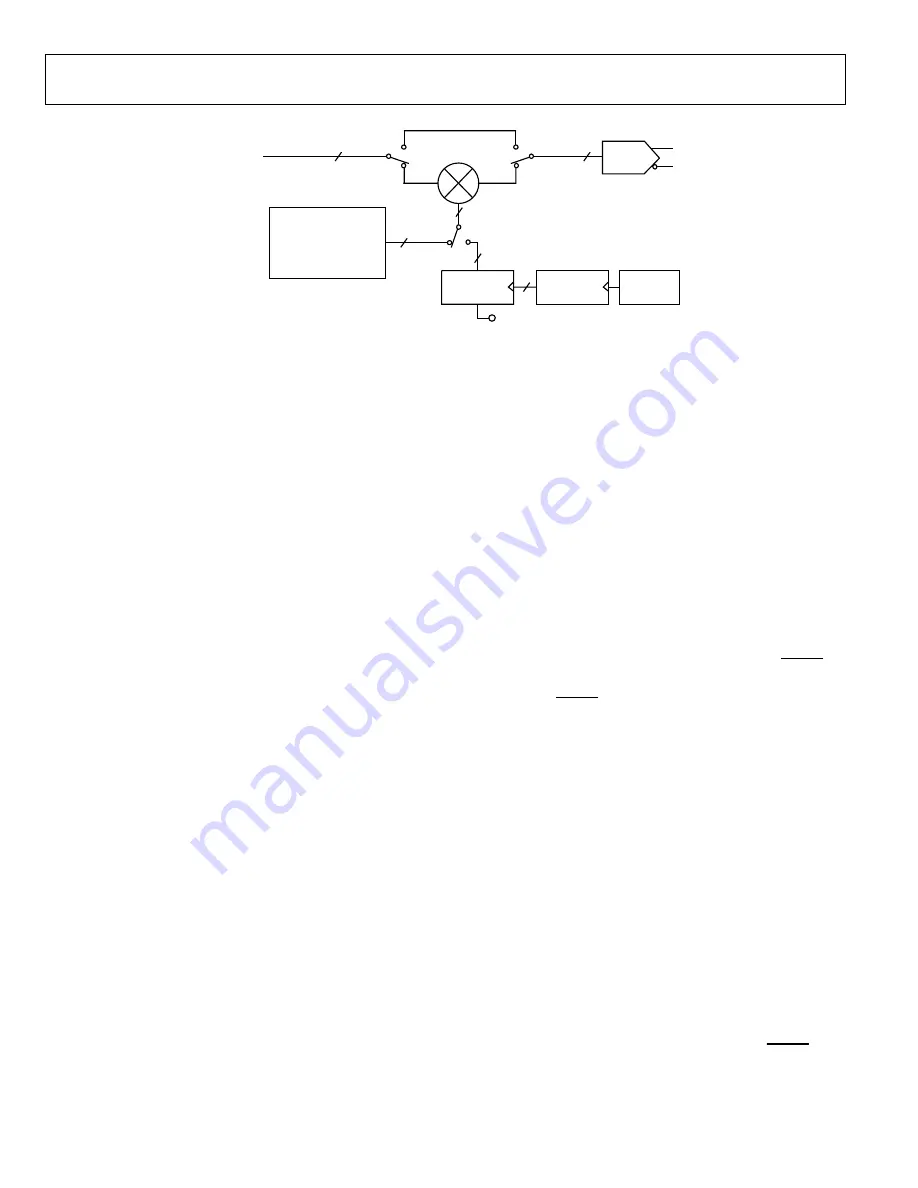
AD9854
Rev. E | Page 30 of 52
12-BIT DIGITAL
MULTIPLIER
12
12
(BYPASS MULTIPLIER)
OSK EN = 0
OSK EN = 1
OSK EN = 0
OSK EN = 1
12
12
DIGITAL
SIGNAL IN
USER-PROGRAMMABLE
12-BIT Q CHANNEL
MULTIPLIER
OUTPUT SHAPED
KEYING Q MULTIPLIER
REGISTER
12
OSK INT = 0
OSK INT = 0
1
8-BIT RAMP
RATE
COUNTER
SYSTEM
CLOCK
ON/OFF OUTPUT SHAPED
KEYING PIN
SINE DAC
12-BIT
UP/DOWN
COUNTER
DDS DIGITAL
OUTPUT
0
063
6-
0
50
Figure 50. Block Diagram of Q DAC Pathway of the Digital Multiplier Section Responsible for the Output Shaped Keying Function
The two fixed elements of the transition time are the period of
the system clock (which drives the ramp rate counter) and the
number of amplitude steps (4096). For example, if the system
clock of the AD9854 is 100 MHz (10 ns period) and the ramp
rate counter is programmed for a minimum count of 3, the
transition takes two system clock periods (one rising edge loads
the countdown value, and the next edge decrements the counter
from 3 to 2). If the countdown value is less than 3, the ramp rate
counter stalls and therefore produces a constant scaling value to
the digital multipliers. This stall condition may have an application
for the user.
The relationship of the 8-bit countdown value to the time
between output pulses is given as
(
N
+ 1) ×
System Clock Period
where
N
is the 8-bit countdown value.
It takes 4096 of these pulses to advance the 12-bit up-counter
from zero scale to full scale. Therefore, the minimum output
shaped keying ramp time for a 100 MHz system clock is
4096 × 4 × 10 ns ≈ 164 μs
The maximum ramp time is
4096 × 256 × 10 ns ≈ 10.5 ms
Finally, changing the logic state of Pin 30, output shaped keying
automatically performs the programmed output envelope functions
when OSK INT is high. A logic high on Pin 30 causes the outputs
to linearly ramp up to full-scale amplitude and to hold until the
logic level is changed to low, causing the outputs to ramp down
to zero scale.
I AND Q DACS
The sine and cosine outputs of the DDS drive the Q and I DACs,
respectively (300 MSPS maximum). The maximum amplitudes
of these output are set by the DAC R
SET
resistor at Pin 56. These
are current-output DACs with a full-scale maximum output of
20 mA; however, a nominal 10 mA output current provides the
best spurious-free dynamic range (SFDR) performance. The value
of R
SET
is 39.93/I
OUT
, where I
OUT
is expressed in amps. DAC output
compliance specifications limit the maximum voltage developed
at the outputs to −0.5 V to +1 V. Voltages developed beyond this
limitation cause excessive DAC distortion and possibly permanent
damage. The user must choose a proper load impedance to limit
the output voltage swing to the compliance limits. Both DAC
outputs should be terminated equally for best SFDR, especially
at higher output frequencies, where harmonic distortion errors
are more prominent.
Both DACs are preceded by inverse sin(x)/x filters (also called
inverse sinc filters) that precompensate for DAC output amplitude
variations over frequency to achieve flat amplitude response from
dc to Nyquist. Both DACs can be powered down when not needed
by setting the DAC PD bit high (Address 1D hex of the control
register). I DAC outputs are designated as IOUT1 and IOUT1,
Pin 48 and Pin 49, respectively. Q DAC outputs are designated
as IOUT2 and IOUT2, Pin 52 and Pin 51, respectively.
CONTROL DAC
The 12-bit Q DAC can be reconfigured to perform as a control
or auxiliary DAC. The control DAC output can provide dc
control levels to external circuitry, generate ac signals, or enable
duty cycle control of the on-board comparator. When the SRC
Q DAC bit in the control register (Parallel Address 1F hex) is
set high, the Q DAC inputs are switched from internal 12-bit
Q data source (default setting) to external 12-bit, twos complement
data supplied by the user. Data is channeled through the serial
or parallel interface to the 12-bit Q DAC register (Address 26 hex
and Address 27 hex) at a maximum data rate of 100 MHz. This
DAC is clocked at the system clock, 300 MSPS (maximum), and
has the same maximum output current capability as that of the I
DAC. The single R
SET
resistor on the AD9854 sets the full-scale
output current for both DACs. When not needed, the control
DAC can be separately powered down to conserve power by
setting the Q DAC power-down bit high (Address 1D hex).
Control DAC outputs are designated as IOUT2 and IOUT2,
Pin 52 and Pin 51, respectively.
















































